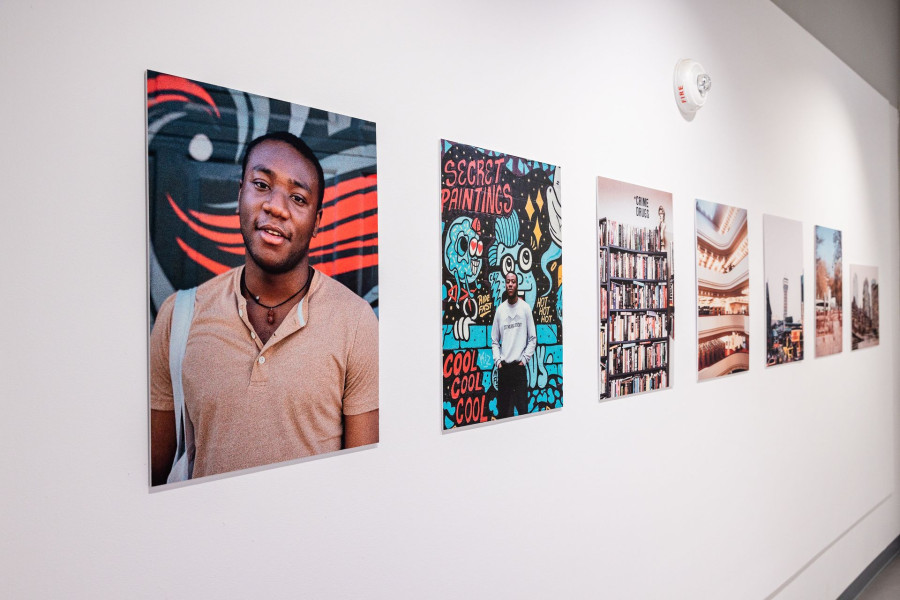Now, think about the entire creative process and what it would consist of—from inception to completion. I guarantee many steps may have been overlooked, especially if we don’t understand the hoops and hurdles creatives jump through to reach the finish line.
Creating a work of art to share publicly is an achievement in itself. We don’t see the hours, sweat, pitching, writing, recording and various levels of production for our favourite creation. The backbone of this are the outlets for funding and support that, unfortunately, don’t come as easily to Black creatives as one may think.
A prime example of this would be the Black music scene in Toronto. While many genres of music have an excess of support and outlets to choose from, Black artists are usually left to fend for themselves or hope to acquire any form of support via their community or specific grants and opportunities, which are few and far between compared to others—or, they go down south. Also, finding funding for endeavours is nowhere near a walk in the park. More on that later.
Compared to years prior, financial backing has shifted in a positive direction, but as the saying goes, the more, the merrier. We’re in need—period. In the mix of things, not having adequate and affordable living quarters and workspaces is detrimental for artists. Without certain outlets advocating for Black artists, creatives, or industry folks, it would be a taxing and even more infuriating journey to travel.
It’s no secret that there are many obstacles Black creatives endure to bring a project to fruition—primarily in funding. One of the most significant sources of arts funding in Toronto, Artscape, is presently in receivership, and artists in the community are at a crossroads. Has the Toronto creative community hit a wall? Or are other funding opportunities as easily accessible as they are touted to be?
Many creatives in the Toronto area are in dire need of the system and facilitation Artscape provides. However, at this time, the vital community institution that has served artists for more than 30 years is now on shaky ground.
Artscape financial woes
Founded in 1986, as per their website, ‘Toronto Artscape Inc. is a not-for-profit corporation that serves as the operating body in the group of Artscape organizations. Each organization serves as a subset of Artscape, covering real estate development, performance and event services, consulting and knowledge exchange, artistic programming and community animation, and creative entrepreneurship development.’
On August 28, 2023, Artscape announced on its website that they were going into receivership. In doing so, it would affect their programming, educational ventures, and, most of all, the vital housing and spaces provided for artist-led families to create and thrive. The organization had to fill financial gaps to offer its list of first-rate services during the pandemic and meet its economic challenges. Unfortunately, it was a hefty checklist that they couldn’t maintain.
Their list included:
- Providing affordable residential and ownership spaces for 265 artist and artist-led families
- Keeping 125 commercial tenancy spaces open
- Serving 500 members of Artscape Daniels Launchpad (ADL)
- Keeping up with 500-plus annual event venue rentals
- Managing employees and administration
Even after the restructuring of financial efforts (and I’m sure other bureaucratic behind-the-scenes issues we will not be privy to but are slowly trickling out from some Artscape Workers United employees) and alongside its inability to sell Daniels Launchpad to repay debt owed to its primary lender, all efforts resulted in significant debt accumulation, the loss of their infrastructure and an elimination of core outlets for creatives in Toronto.
Artscape’s foundation is essential for creatives
What Artscape provides to the city is detrimental to creative circles. You may have friends who live at one of their artist residences. Perhaps you’ve seen a few shows at one of their many venues. Or maybe unbeknownst to you, you’ve listened to a podcast or two that was recorded at one of their facilities.
Marlon Palmer, aka That Dude McFly, is a well-known Toronto creative affected by the recent Artscape news. He is a proud member of the Artscape community and a staunch supporter of everything they do. Known for his dynamic event-hosting and popular podcast Extra Gravy, Palmer is a notable fixture in podcasting. At a pivotal time of the show, he went from taping his podcast in a condo lobby to partnering with Artscape in future ventures. “We were in between looking for studios. Through friends, we spoke with Artscape and solidified a partnership where we would help promote the space and host events in return for having time in the space every week."
It wasn’t only about the required space. Palmer shared how much Artscape provided for him along the way. All actions helped to skim down on critical finances for Palmer and his team. “They did a great job with us. They were there to set up or help us with equipment and provided top-of-the-line equipment. Plus, they gave us free rein to create at our own pace. We’ve had some of our biggest guests in that studio, and it probably wouldn’t have happened if it wasn’t for Artscape. I’m pretty happy with how we were treated there. I have no complaints in terms of service.”
On the other end of that spectrum, the repercussions of Artscape’s receivership are pretty costly.
Palmer finds himself in a position where he has to make creative decisions that will affect his bottom line. “Now we must pay for a space, relocate, and work that all out with equipment. We wouldn’t normally have to do these things because Artscape provided that. Now, every week, we’re paying for rental equipment out of pocket. And with podcasts, it’s not like you’re making money weekly. You’re already operating in the red.”
Facilitate the funding
Over the years, while interviewing many Black creatives, I would always be taken aback to hear, “It’s so difficult to find funding to support my project.” While there have been fantastic initiatives for support produced for the community by several emerging platforms, sometimes maneuvering through acquiring funds under the guise of ‘diversity and inclusion’ is no laughing matter.
Sandy Hudson, co-founder of Black Lives Matter and social justice creator, recently launched Above The Palace—a new production company with her partners Rodney Diverlus and Anubha Momin. Their first film, Aftercare, debuted at TIFF, but the road to the end goal had its challenges when it came to funding.
Having a production company with a diverse cast and falling into the proverbial funding box can prove to be troubling. On their short documentary Aftercare, the executive producers behind the project consisted of a Trinidadian, a Mohawk woman and a Jewish man with a South Asian writer. Hudson quickly realized that if certain boxes weren’t checked to pacify the application receiver, the funding simply wasn’t available.
If you don’t fit the requirements and fall outside the proverbial box, you will find yourself back at one. It becomes a game of ‘you’re not Black enough’ or ‘you’re not Asian enough.’ The convoluted wording and layout of how it ‘has’ to be from a funders' perspective is a blanket view—a one-size-fits-all that doesn’t work for everyone—especially Black creatives whose projects are either created with Black, Indigenous, or People of Colour throughout.
“I think where we are at in Canada that we could be a little bit less superficial on is the way that we fund and support stories because right now, one of the things that we've come up against as a company is we're a little bit too diverse, according to the Canadian landscape. And that has been frustrating for us,” says Hudson.
Palmer concurs. “It’s like they have a set checklist of select wording. And if you don’t knock off eighty out of one hundred, it’s over. Finding and applying for grants can become such an exhausting process. People tend to give up and stop trying after a while.” Hudson believes the necessary changes must occur now to move forward with more equally balanced opportunities. “What needs to happen is we need to get to a level of nuance and complexity that truly does support all of these creators who are desperately trying to find support for the projects they're making, ” says Hudson. Her words ring true not just for film but all facets of creativity.
Where the crisis lies
Entrepreneur and Sandbox Studios’s founder Kiana “rookz” Eastmond is tapped into the creative sector in the city, and she believes creatives are in crisis in Canada—especially Toronto. She started her journey as an artist and understands all too well how the right support can go a long way. However, speaking with rookz opened up yet another interesting perspective in this conversation. While many are losing a phenomenal resource like Artscape, what if there was no Artscape? Her reasoning comes from the understanding that assistance from outlets such as Artscape was created to supplement your journey, not fully fund it.
“I believe organizations like Artscape are incredible. The work they’ve done to protect artists' interest in a space is integral and powerful. But one of the things that I’ve always said about Canada’s funding system is that it should come with capacity and increase. While I appreciate social support, it’s also important that people are able to grow while they have the opportunity to experience support.”
This is a valid point. As much as creatives love to bring art into existence for their enjoyment and the sake of societal enrichment, artists do have mouths to feed and shelter to pay for—whether for themselves or a family unit. How can they do so moving forward if they’re not taught the basics of surviving independently? Ideally, rookz believes that teaching creatives how to thrive without funding will give them the tools needed to avoid the starving artist trope.
What economic development is happening on the backend to ensure this isn’t permanent? It shouldn’t be a permanent situation but a buffer to help artists create and learn the business of their trade. “If artists cannot make money off their art, it doesn’t matter how many programs we create to support them. For some of the bandaid solutions we create, we have to start having long-term thoughts about how this impacts people overall. And we’re the ones who get impacted the most. When we can receive government funds to create economic relief, we also have to do economic education,” says rookz.
To sum it up, rooks says, “Use the support. But the support cannot become a lifestyle.”
During the pandemic, it was the work of creatives that kept a lot of us sane. Whether it was DJs on Twitch, Verzuz on Instagram, or rereads of Broadway plays on YouTube. That’s a clear indication that creators are valuable, essential even for our self-care; for us to unwind and be free during the 24-hour clamour we live daily.
At the time of this writing, Artscape created a special campaign called ‘Support The Creative Community,’ supported by the partners and community to help the creatives affected by the news. Also, as per our mayor, Olivia Chow, on September 2, receivership was delayed for 30 days with support from TD Canada Trust and the city. Unfortunately, that deadline is swiftly approaching, so we must stay tuned for what’s next for the arts community.
Palmer made an interesting point before we signed off that rang true. Imagine what we can do with the right support system behind us. Toronto is a city brimming with creators. The results can be unfavourable if the city or government doesn’t pour into or apply vested interests into our creatives. It’s really that simple.
“When I look at artists like Drake, Jessie Reyez, and Abel Tesfaye, aka The Weeknd, that have been in the arts with very minimal support and look at what they’ve been able to do, imagine if you were to provide some support! Many artists just need peace of mind, so they can flourish.”

 By
By 





